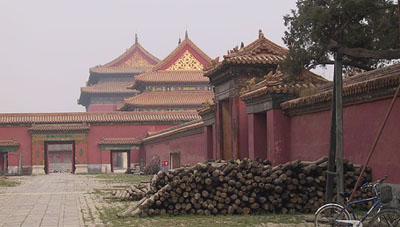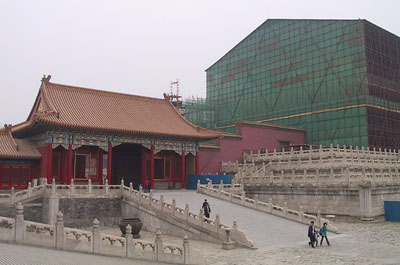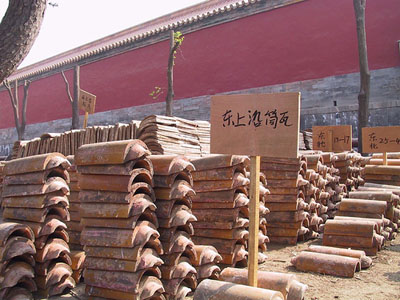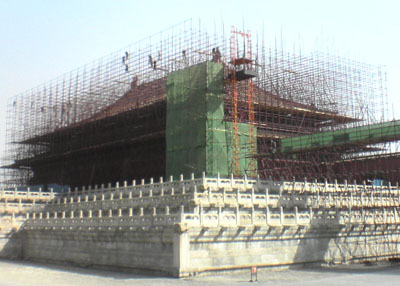The Forbidden City: Beyond Space and Time
Yesterday in Beijing, China’s Palace Museum and IBM jointly announced The Forbidden City: Beyond Space and Time, the project that I’ve been working on for over a year. Consistent readers of this blog (yes, you three) know that I spend a lot of time in China and so it is a great relief that the cat is officially out of the bag. Not that I’ll be diving into excruciating detail in future posts — gotta save some surprises for the actual launch in 2008, right? — but it should give a bit more context to my musings.
So, what’s the project? Well there’s the official press release and the Palace Museum’s statement (in Chinese). The Chicago Sun-Times decided to take the local angle on the announcement and ran a flattering piece on me and my team. The paper even gave Ascent Stage some love.
But what is Beyond Space and Time? Well, announcements like this at the beginning of a project are always tricky since it is the nature of multi-year, first-of-a-kind efforts to change drastically from vision to implementation. But you have to start somewhere, so here’s the vision.
The heart of Beyond Space and Time is a virtual online replica of the Forbidden City. This is not a set of traditional webpages but rather a fully immersive, spatial, populated world that corresponds architecturally and historically to the vast grounds of the current Palace Museum. And not just pretty building models to ogle at. We call it a Participatory Cultural Environment to stress the importance of a space alive with people — other visitors who you can interact with and, if possible, computer-controlled representations of historic persons. Though 3D representation is widespread in the field of cultural heritage (primarily for preservation), this kind of multi-user, education-focused cultural worlds does not exist.
If you know Second Life, you’re familiar with non-game-based 3D virtual communities. Second Life is an inspiration and even a development sandbox for us (no SLURL, we’re on a private island for now — but we did recently take a SL team portait), but we’re evaluating many platform possibilities. It is sometimes said that people who visit the real Forbidden City leave thinking that they’ve missed the actual Palace Museum. In fact, the buildings and grounds (and of course the artifacts therein) are the Palace Museum; it is not a single building with nice glass cases and wall placards. This is the primary reason that our virtual version is a spatial world rather than a more traditional web front end (however tricked out) for a database of media, as we did with the Hermitage and Eternal Egypt. The museum is a city and the best way to experience a city is by moving through it and interacting with others in it. Call it the sidewalk approach to cultural heritage.
There’s an historical aspect too: that’s the beyond time part. We envision being able to move between a few discrete historical moments in the centuries-long evolution of the city. The environment will morph architecturally and of course the storylines embedded in the world will correspond to the historical moment. System design verges on science fiction here as we move through the implications of a community space that exists on different timelines. For example what happens to the field trip group when some of your classmates decide to peel off for the 16th century?
Of course, a virtual simulacrum of a physical space isn’t much fun if it doesn’t have points of tangency with the real world, now is it? We’re working with our museum partners to identify places inside the Forbidden City where visitors who are physically there can interact with the virtual version of the space. We’re evaluating different location-based services — from projection in the palace halls to mobile device interaction. The idea is to break down the strict distinction between the real world and the virtual world, to let one enhance the other. Challenges like this are one of the many reasons IBM undertakes and funds projects such as Beyond Space and Time.
There’s an aspect to the project that is personally very exciting and not yet reported in the press. Modelling 800 buildings to a level of appropriate detail isn’t something that can realistically be achieved by 2008. We realize this and actually think it is a blessing in disguise. Inspired by the Ancient Spaces project which itself takes a Wikipedia-like approach to collaborative content development, we propose to open the modelling effort to the global community of developers. When exactly this will happen and certainly how it will work is still to be defined, but if you are interested in being part of the distributed virtual construction crew drop me a line at .
In North America I am working with some very talented designers and developers, many of whom have years of experience from earlier museum projects. In China we're working with specialists from IBM's research lab in Beijing as well as a team at the Palace Museum who are as technically-savvy as they are informed about the history and culture inside the Forbidden City walls.
So, then, back to work.
[Note to those of you who read this site's feeds: I've played with a kind of spatial hyperlink that adds some extra information to this post. The content, alas, is not part of the RSS feeds. Drop on by the site if you'd like the extra morsels.]
UPDATE: The virtual world is live and can be found at www.beyondspaceandtime.org.
Culinary turntablism
Does anyone remember the scene in The Golden Child — maybe I should first ask, does anyone remember the movie The Golden Child? From 1986, with Eddie Murphy? Not one of his best. There’s this scene where he enters a Nepalese temple and encounters a ceremonial pillar that rotates around its vertical axis. Not knowing what to do, he scrubs it like a turntable DJ, making a scratching noise. Laughter ensues.

I think of that scene when I eat out in China because of the mechanism known as the zhuan pan at the center of the table. Known in the west as a lazy susan, this rotating platter is a fixture at traditional tables in China. It is both an efficient delivery mechanism and a wonderful social lubricant. Everything is communal and by definition participatory as the platter rotates forth and back. You just reach in with your chopsticks as a dish you like comes by. If you can get beyond the sanitary issues of this particular disease vector it becomes clear that the zhuan pan is a marvelous thing.
There’s something musical about the whole process. The zhuan pan is a DJ turntable set up.

Consider it this way. The dishes are notes/chords/samples — discrete musical units of some kind. They appear at a point in time on the platter and rotate more or less consistently until they are removed or moved (more on this in a moment). So you have discrete units repeating in time from the perspective of a fixed point which in this case is me, the eater, but metaphorically is the armature of the phonograph. Units are added in time, layered in so to speak, and repeat at the same interval. Dishes leave the table periodically — their particular musical loops end. But the dishes return, smaller this time (the waitstaff transfers uneaten portions to smaller plates to make more room on the table) and they are placed closer in to the center of the rotating platter, allowing people easier access to the newer, fuller dishes at the periphery. In other words, the loops return in a changed state and with new, quicker intervals (rotating more quickly since their radial distances are now shorter). The zhuan pan rotates backwards too, but only quickly, a “scrub” if you will, to let someone grab a morsel that made its way by too quickly. The overall motion is forward.
Data visualization geek that I am I started considering the possibilities — which of course weren’t visual at all but more like data sonification (a field to be sure but not one much popularized). What would this meal sound like if the zhuan pan were a recording?

So I recorded each dish as a separate track in GarageBand. Each measure corresponded to one minute of the meal starting with the arrival of tea, which is the downbeat bass drum that remains constant throughout, the engine of the entire affair. Each new dish comes in more or less as I recorded it on a timeline in my notebook during the meal. (My hosts graciously obliged my notetaking as the curiosity of a unaccustomed Westerner.) Some dishes are single notes, some are short phrases, and at least one, the fish “flower,” is a constant note modulating in time with the rotation of the table. Each unit repeats with a period of five minutes. This is an average based on the number of revolutions of the table, but it is almost exact for at least the first two rotations of the 50 minute-long meal. With the exception of the tea-beat, volumes fade out for each track based on the consumption of the dishes. As noted above, the period of at least one dish, West Lake soup (represented by the piano), speeds up midway through the meal as it was transferred to a smaller plate and move closer to the center of the table, rotating faster. The two vinyl scratches correspond to an extended counter-rotation of the table. At 60 BPM one second correponds to roughly one minute of elapsed meal time. I think the time signature is 5/4, but I’m rusty on my Brubeck so who knows.
It is not what I’d call a chart-topper, but it isn’t cacophonous, though at quicker BPM’s it does get a bit muddy. I clearly could have done more. Instrumentation could be made to correspond more closely to the food type. (But what does “silver agaric” sound like?) Discord could be used to suggest tastes I did not care for. But the general idea is clear. Maybe on the next trip I can videotape the whole thing for the time-lapse music video this cries out to be.

In China you often encounter a circular jade plate known as a bi. It is ancient in origin and its purpose is not completely understood. The bi is flat and usually has a circular hole at the center. Movable type, gunpowder, paper. The recordable disc?
8 days (crammed into less than) a week
That’s pretty much how I feel as I recuperate from an exhausting four days in Beijing.
This was the first trip to China where I truly experienced Wikipedia withdrawal. You really don’t know what you’ve got until it is blacklisted by a state government. I worry about the larger implications of this.
I always chuckle at the Chinese entry document when you are asked to check the box corresponding to your intention: Business, Conference, Official, Other (huh?), etc. There’s a box that says Settle Down. I’m tempted to check it. What does that mean? Give me your poor, your tired, your crazed Westerners looking to just settle down? I imagine the schoolmarm at passport control looking at me stoically and saying “You just need to relax, hmmm?”
I’ve realized now, after my seventh trip to the Far East, that the timeshift is truly diabolical. I suppose it is my own fault. When working in Europe and the Middle East you basically have an elongated work day. Do your thing there, return to the hotel, log on, work with your colleagues back home for a few hours at the start of their work day. In China, it is like this but with about a five hour gap between the end of the Chinese work day and waking Americans. After a few days of this the only reasonable thing to do is sleep during this period. Which completely destroys any hope of a sustainable schedule. The day becomes split: awake 6am-6pm, sleep 6pm-10pm, awake 10pm – 2am, sleep, etc. Awful. Maybe I should just treat it like a vacation from work back home.
That said, I can’t complain. Working at the Forbidden City is a special treat. IT geeks are almost always housed in basements, dungeons, or worse — and when I work there I am in a temporary trailer — but how bad can it be when you step out to this?
The Forbidden City is surrounded by a wide moat on all four sides. It is stagnant and forboding, as a defensive moat should be, I suppose. Yet, there are always a few dozen people fishing in it. I’ve never seen anyone pull anything living out of it, but from the size of the poles they use (without reels) I am pretty sure they are angling for some sort of slithering leviathan the size of a bus.
Our colleagues at the Forbidden City again hosted a ping pong tournament. I should have learned from the first drubbing last year. I think I lost 11-7, 11-8 which sounds way closer than it was. Yes, my opponent held his paddle upside-down, yes he stood way the hell back and played many of my shots after the ball had dropped below the plane of the table on his side, but what really threw me off was his serving ritual. He’d pet the table up by the net, move back, bounce the ball slowly on his paddle held parallel to the table, tuck it all back in close to his body (so I could not see it clearly), then whip out a serve that never went where I thought it would. If I managed to return it the shot was so lame that I was shortly searching for the ball ricocheting between server cabinets way behind me. Still, it was good fun and I really love that Chinese television always has professional ping pong coverage on. Taunting, yelling, sweating, injuries — the way ping pong should be.
Regeneration
In The Future of the Past, Alexander Stille expands on a comment by Italian conservator Michele Cordaro:
“The Chinese, like the Japanese and some other Asian nations, have a tradition of conserving by copying, or rebuilding.”
Conserving by rebuilding made considerable sense in China, where, until recently, virtually everything — palaces, temples, and houses — was built of wood. Paradoxically, in architecture, working in perishable materals could potentially offer a superior conversation strategy: rotting wooden parts could simply be replaced as needed so that, just as our bodies replace their old cells with new ones while we remain “ourselves,” the buildings would be constantly regenerated, remaining forever new and forever ancient.
Seems logical, but in practice Western conservation is based on a philosophy of repair rather than replacement. This stems from the West’s long privileging of permanence and originality in art (even when what we praise isn’t in fact permanent or exceptionally original). Copies are considered at best qualitatively lesser; at worst, acts of piracy.
These conflicting attitudes toward monuments are related to profound cultural differences. China and Japan have traditionally had a cyclical view of time. Dynasties would rise and fall, be replaced by new ones, but, like the Forbidden City, reemerging from its latest fire, remain fundamentally the same: each ruling group held the “mandate of heaven” …. In a world that was both eternal and ever-changing, rebuilding monuments made perfect sense.
This past week I had the good fortune to be invited on a tour of the renovation of the roof of the Hall of Supreme Harmony at the Forbidden City in Beijing. This is the most important of the hundreds of buildings at the Forbidden City, now known also as the Palace Museum. The whole museum is being upgraded (as is all of Beijing, for that matter), but the work is most intense at the Hall of Supreme Harmony where a giant scaffolding and tent covers the swarm of workers who are in the process of removing the thousands of decaying terracotta tiles to get at the wooden infrastructure of the roof. The tiles are being meticulously removed and remade. The roof itself is imperceptibly sagging and this will be repaired too. The intricately painted outer beams will be repainted, resulting in stunning before and after comparisons. (Full photoset tour at Flickr.)
This is a less extreme version of wholesale rebuilding of cultural sites that Stille details in his study of Chinese conservation, but it is an example nonetheless. Only a specialist could point to what is original to the hall’s 1406 construction and what parts are copies installed since. This happens in the West too, of course, but the difference as I’ve experienced it in China is that it doesn’t matter. The originality of the building is the idea of it, what it represents.
The Palace Museum has a partnership with the Japanese printing company Toppan to create a detailed, high-resolution virtual replica of the Forbidden City. Right now only three of the main halls, including Supreme Harmony, are complete. The effect of moving about the virtual grounds in the wrapround-style theater is powerful, though in the people-free virtual model the awe created by the buildings’ scale is missing. There’s little aura to the simulacrum. The model will improve, of course, as the technologies of virtuality improve.
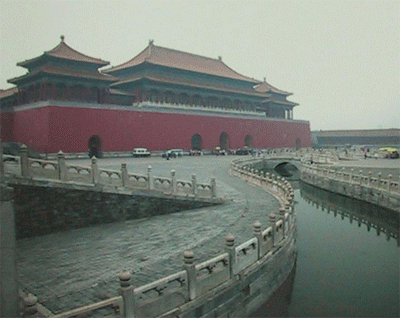
Comparison of a photograph and a still from the virtual model
No one claims that the model is the Forbidden City, but then you don’t get the usual quasi-apologies about its not being the “real” thing either. Most 3D modelling in cultural heritage is done for a specific purpose — reconstruction of what has been lost, for instance — and is treated as a teaching tool or a research resource. Not so at the Palace Museum. It will be interesting to see how this copy evolves.
Chinese Labor Day
You know that scene in Father of the Bride II where Steve Martin has the route to the hospital intricately plotted out in the event that his daughter (or was it wife) goes into labor? I laughed when I first saw that, pre-kids. Now it makes me laugh for a different reason, since that kind of detailed plan is bound to go awry. You’re almost asking for it to, taunting the due date gods to throw you a curveball. Short of scheduling an induction — and even that can be unpredictable — there’s really no way of knowing what is going to happen or, more specifically, when it will happen.
Which is why there’s palpable concern in my house over my departure today for China. With flights leaving for the US only during a certain window of time and the jaunt taking somewhere in the neighborhood of 14 hours, there’s almost no conceivable way I could make it back if my wife suddenly went into labor. Sure, this is highly unlikely. She’s neither dilated nor effaced. But then, our second son was three weeks early — and week 37 begins precisely as I am arriving home. So does the Chinese May Day week-long holiday.
Let’s hope China’s celebration of labor and mine happen half a world apart.
Taikographs
My pal Victor in Beijing presented me with this set of signed commemorative postcards from China’s first two manned spaceflights. The outer envelope, pictured here, contains the signatures of Yang Liwei, China’s first man in space, and Fei Junlong and Nie Haisheng, the occupants of the second ship up. Inside are three separate cards corresponding to the individual taikonauts, also signed.
Victor got the autographs because he works closely with accessibility organizations in China and so he knows the head of the China Disabled Persons’ Federation, Deng Pufang, the son of Deng Xiaoping. With a dad like that Deng Pufang of course has friends in high places and thus were Victor and the spacemen at the same reception. Deng Pufang, by the way, became a paraplegic during the Cultural Revolution as the result of falling from a fourth floor window to escape torture.
View > Show > Grid
The Palace of Supreme Harmony at the Forbidden City in Beijing under renovation. The pace and quality of the upgrade is staggering.
See also my helpful guide to Chinese toilet iconography on Flickr.
Spring Fest

Chinese around the world today welcome the Year of the Dog during Lunar New Year festivities. By some accounts the transit of people inside the PRC to see loved ones for the long holiday is the largest migration of people on the planet. If the density of human bodies in airports and rail stations when it isn’t Chinese New Year is any indication, these accounts are to be believed.
I’ll be in China frequently this year with dispatches posted here accordingly. Here’s hoping Year 4703 is a prosperous and happy one!
Meet the Friendlies
China recently unveiled the sporting event pictograms for the 2008 Olympics. I’ve been a fan of these little icons since Australia somewhat amazingly created one for each sport using little more than boomerang imagery. Athens continued the trend of using culturally-specific imagery in the pictograms by styling each event icon as if it were found etched on the side of an ancient amphora. (What, Plato never played ping pong?)
But China has gone further, entering the realm of the awesome and bizarre. Meet the Friendlies. The five main mascots — Beibei, Jingjing, Huanhuan, Yingying and Nini — are endearing and meaningful (spelling out “Welcome to Beijing” among other things). It can’t erase the horror that is the Whatzit mascot from the Atlanta games, but it helps.
Their cuddliness is deceiving, though. The actual sport pictograms truly kick ass.

From left to right that’s the Modern Pentathlon, Taekwondo, and Shooting, also known as Plunder, Uppercut, and Make My Day.
More on Olympic pictograms and logoing:
The Graphic Design Olympics
A Mini History of Olympic Pictograms
Logos and Mascots
Blown home
Typhoon Haitang has blown through Taiwan and buried itself on the mainland. As category 5 hurricanes go this one was surprisingly mild, I’m told. The eye skirted Taipei to the south so we missed the worst, though it did get damn windy there for a few hours. Trees that were individually lashed down were uprooted and rows of parked scooters were scattered like Matchbox cars, but there was very little flooding and no broken windows that I could see. Frankly, it was anticlimactic — which is probably exactly how extreme weather should be. From my hotel window I could see a lone 7-11 convenience store. It was my little measure of how bad things were getting. It never closed.
Unrelated. If a cell phone company can know enough about your whereabouts on the global network to charge you international roaming rates then surely the technology exists to warn callers that a call recipient is in a radically different time zone, no? It would be great to receive an alert like “Are you sure you want to dial [name]? It is 3 AM in his timezone right now.” Oh, and to the person who called for a password in the middle of the night: I have virtually no recollection of our conversation. How’s that for password security?
Time to go home.

